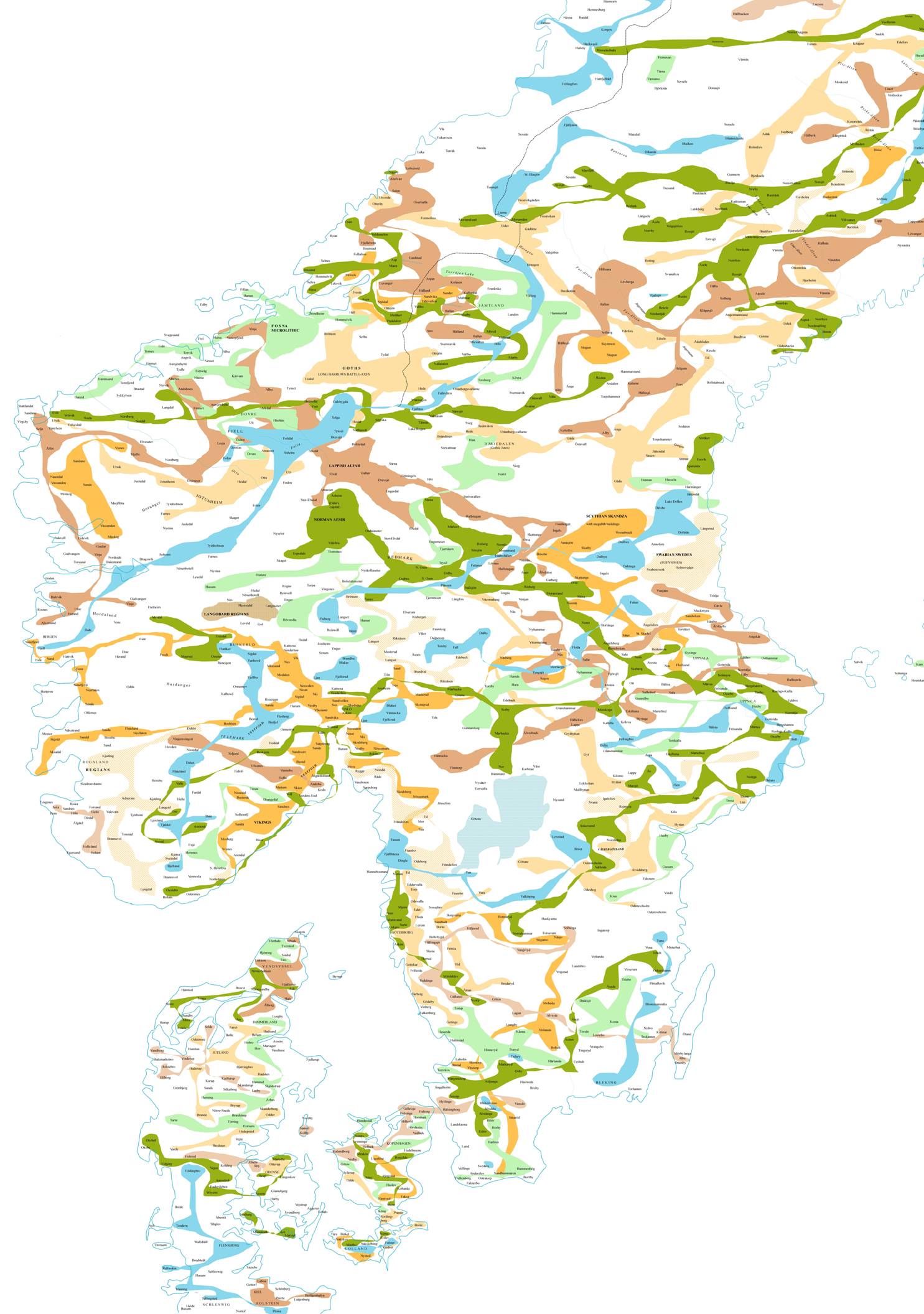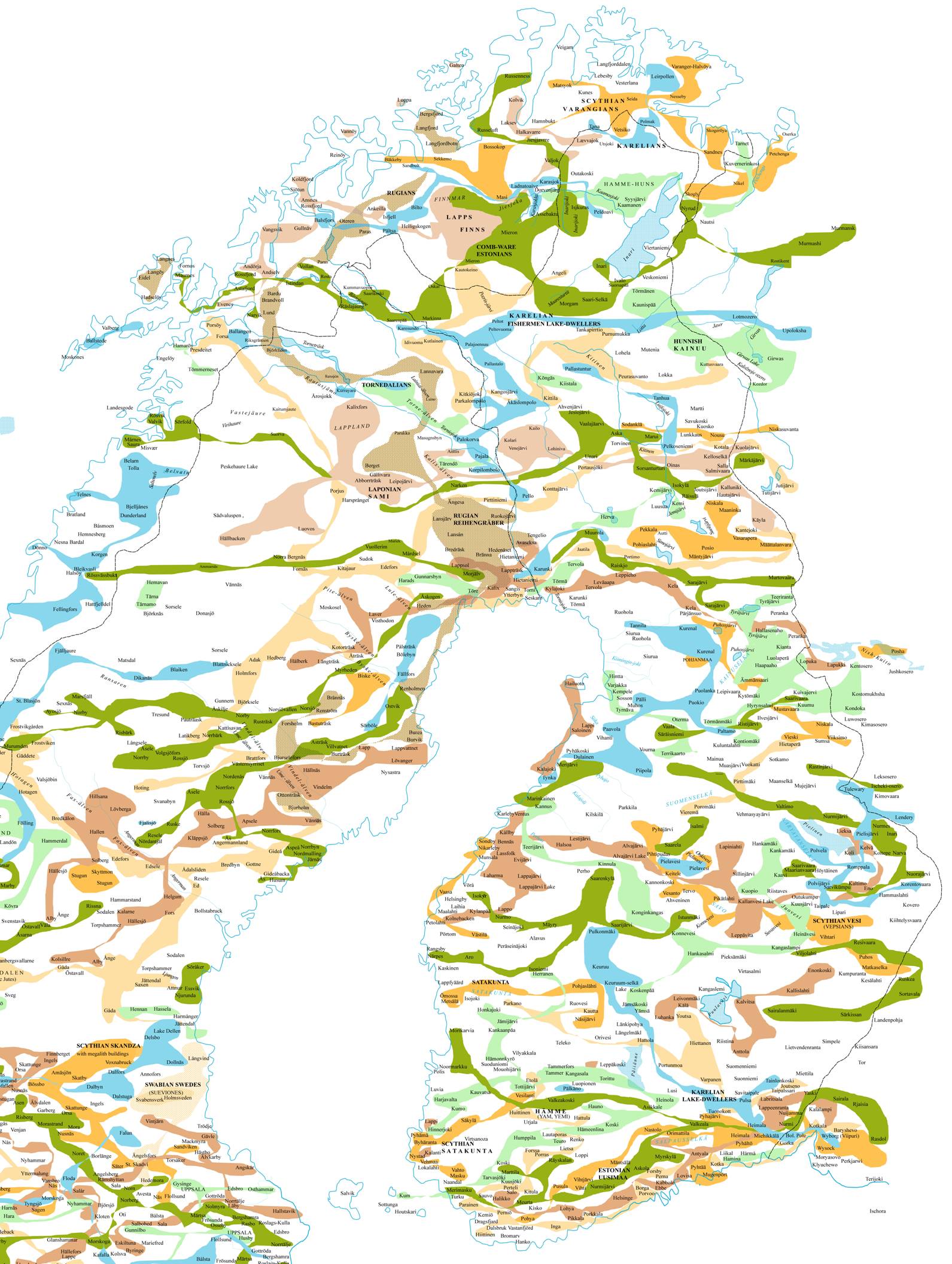|
|
The
Racial Varieties of Scandinavia
The anthropological situation in
Scandinavian countries can be described best by maps surveying the distribution
of anthropometric cranial and ostial indices. Classical theories could do
with distinguishing only Nordids, Lappids and Baltids. Biasutti’s racial survey of Scandinavia included only Nordidi, Lappidi, Baltidi and Uralidi. Egon von Eickstedt saw two main
Scandinavian subtypes, the light-skinned helle Nordrassen and mitteleuroasiatische
Kurzköpfe ‘Central Euroasiatic short skulls’. The former included nordische Rasse in the
west and ostbaltische Rasse in the east. Their leading element was
represented by the western Goths and Frisians, who had double-gangers in the
eastern Yotwingians and Prussians in the Baltic area. The latter group
consisted from the ostische Rasse of Uralids and the lappische
Rasse of Sami people. Later he reclassified their opposition as contrast
between the short alpine Rasse and the tall ectomorph osteuropide
Rasse.
Map 20. Racial
varieties of Scandinavia
Coon’s
drawing on Map 19 and our draft on Map 20 identify the genuine Germanics with
the racial minorities of Tronde people inhabiting the provinces of
Trøndelag, Hardanger and Hordaland. Beside Trøndelag on the
western coasts of Norway, they trace the Tronde phenotype also in Scotland and Iceland. In our view the Tronde district in Norway neighbours on a colony of Orkdal Scandids and their
populations need a neat disambiguation into Germanoids and Scandids. The
purple cross mark indicates the Tydal tall pigmented type with short legs,
long arms and short wide snubbed nose. It looks like Ripley’s Palaeo-Negroid
‘old black breed’.
Scandids. In the
northern Germanic countries the shortsized brachycephalous Lappids competed
with tall brachycephalous phenotypes, who may
be denoted as Scanians or Scandids. Before Carleton S. Coon published The Races of Europe, his
predecessors evaluated all Scandinavians as tall, white-skinned and
fair-haired Nordids. The racial variety of Nordids was neglected as a negligible
mutation of Nordic types without paying heed to its peculiarities. Its
specific traits consisted in the large-headed brachycephalic cranium and
convex leptorrhine nose accompanied often by red hair and pinky or reddish
colour of skin. Coon split their groups into the neat subdivisions of Borreby, Trønder, Orkdal, Hardanger, Brünn
and Dalo-Falid types and realised that such an uneven dispersion
of principal traits and seats indicated archaic origins from earlier
colonisations. Their distribution is traced on Map 21.
|
Scandids: Scandinavian,
Scania, Scandza, Varangians
Scythoid ethnonymic
associations: Scand/Skyth/Chud’, Varang/Ingr/Ugr-, Bask/Mas-, Mat/Med-
Dialectal markers:
category of determination, postpositive articles, opposition of definite
and indefinite determiners, plurals
in -en transformed into n-stems
Gothoids (long-barrow inhumators, c. 9,000 BC): Jutland, Kattegat, Agdir,
Jaeder, Gottia, Götaland,
Gautigoth, Ostrogothae, Vaster Gotaland, Adogit,
Gotland/Gottia, Vagoth, Hadeland, Otingis
Gothoid ethnonymic associations: Goth/Jut-, Fris-, Lang/Angl-,
Sas/Sax/Sen-
Dialectal markers: correlation of voiced and surd
consonants, voiced sonants, gender opposition of
animate and inanimate nouns, rich inventory of lax
non-tense long vowels, diphthongs and triphthongs
Swabians (c. 100 AD): Swedes, Suetia, Suiones,
Suehans
Rugians (c. 100 AD): Rugi, Ringerike, Rogaland, Ragnarici
|
|
Cimbroids (microlith tribes): Hordaland, Herules,
Herdal, Trøndelag, Jamtland (< Finnish Hämme)
Cimbroid ethnonymic association: Her/Herm-, Teuton/Titan-,
Thor/Tur-, Hun/Kymr/Cimbr-, Kas/Hes-
Dialectal markers: correlation of fortis and lenis
pulmonic plosives, cacuminal/apical retroflex consonants /ɖ
ɳ ʈ ɭ/,
their decomposition into r-affricates /dr tr/
and dephonologisation into clusters dr, tr, lambdacist
shifts of d, t, n and l into r-sounds,
geminating lenis plosives, reduced unstressed syllables with lax vowels,
front rounded vowels, umlaut vowel synharmony, plurals in -er, SOV and GenN word order,
analytic constructions with participles
and gerunds
|
|
Danes: ethnonymic associations Pol/Phal/Flem-, Dan/Daun/Ting-, Del/Dal-, Lat/Let-
Epi-Aurignacian blade cultures: Danes, Lolland, Falster, Blekinge,
Telemark, Fjell, Dalarna
Dialectal markers: laminal retroflex consonants /ɖ ɳ ʈ ɭ/, their decomposition into l-affricates /dl tl
nl rl/ and dephonologisation into clusters dl,
tl, lambdacist shifts of d,
t, n and r into l-sounds, geminating
lenis plosives, reduced unstressed syllables with lax vowels
|
|
Æsir, Asen: the ethnonymic association Mar/Nor/Nar-, Os/Ias-, Sarm/Ser-, Aors/Rus-,
Walch/Volc-
Halstattian Sarmatids: Ascomanni, Nerike, Romerike,
Raumarici, More, Norbegia, Norrland, Inari
|
|
Alpinids: the ethnonymic
association of Alfar and Vanír: Vend/Fin-, Hal/Gal-,
Alb/Lab/Lapp-
Lappids: Hallin, Halland, Helsingland,
Ventheland, Halogaland, (Screre)fennae, Finlappelandth, Kalixmål
Dialectal markers: a rich invertory of patatal consonants /pi
ti ki ni li/, post-alveolar sibilants and post-alveolar sibilant
affricates, fronting back rounded vowels by shifts /u/ > /y/, /o/ > /ɜ/,
nasal vowels, rich diphthongisation, tonal pitch accent, hydronym place
names in -a, unreduced singular and plural endings in -a,
vocalic plurals in -e, -i, opposition of masculine o-stems
and feminine a-stems
|
Table 33. The multiethnic
composition of Scandinavian Germanics
Extracts from Pavel
Bělíček: The Analytic Survey of European Anthropology, 2018, pp. 87-105
|
|


